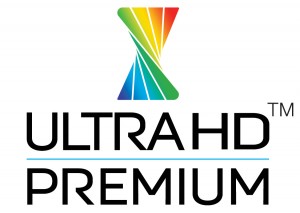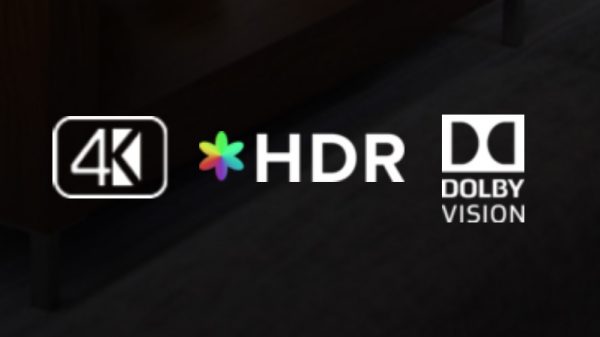
Ever wonder what the “HDR High Dynamic Range” sticker on Ultra HD Blu-ray Discs means? Or, what the Dolby Vision and HDR10+ logos mean on the back of a 4k Blu-ray Disc case? HDR stands for “High Dynamic Range” — a technology that produces a greater range of luminosity than possible with traditional digital video, digital cameras, and digital cinema cameras.
On 4k TVs, 8k TVs, and some device screens (see this list of phones and tablets), HDR allows an expanded range of brightness to produce realistic and detailed images. Images have a greater contrast between light and dark compared to traditional screen images. With HDR, darker and lighter areas are able to render more detail, and colors can be reproduced more naturally, allowing more luminance and vibrant color range.
In photography, dynamic range is measured in exposure value (EV) or stops. An increase of one EV represents a doubling of the amount of light. In dark areas, more exposure is needed to reveal details. Traditional photographic methods cannot provide the same dynamic range as HDR technology in one exposure. HDR images can be produced by merging three exposures of a scene: one natural, one darker, and one lighter. See this Adobe Photoshop reference.

HDR & 4K
4K Ultra HD refers to the number of pixels on a screen (3840 x 2160 / 8.3 megapixels) which is 4-times the Full HD (1920 x 1080) standard. Although the line resolution is widely expanded, HDR technology is more concerned with making every pixel perform better than traditional methods, improving in brightness and color and expanding the color palette. The combination of both technologies (HDR & 4k Ultra HD) can produce extremely realistic imagery.
Where is HDR available?
Streaming Media
Select streaming movies and TV shows are encoded with HDR specifications (either Dolby Vision, HDR10, or HDR10+). Apple TV 4k, Amazon Prime Video, Movies Anywhere, and Vudu are services that offer titles with HDR. For example, Amazon Original Series The Lord of the Rings: The Rings of Power, Apple’s Foundation, and Netflix’s Rebel Moon all stream with Dolby Vision HDR. It should be noted that streaming may be in one HDR format but converted to another depending on the output screen or device. It should also be noted Apple TV+ started offering titles in HDR10+ in November, 2022 with the launch of the third generation Apple TV.
Blu-ray Disc Media
Most Ultra HD Blu-ray Discs now include at least one HDR format, but may often include support for both Dolby Vision and HDR10. HDR10 was improved with HDR10+ by changing a static set of metadata to one that changes dynamically throughout the video stream. Some disc publishers are offering HDR10+, the first of which was Lionsgate’s Robin Hood (2018). Look for the HDR sticker or Ultra HD Premium logo on Blu-ray Disc packaging (Ultra HD Premium ensures the product meets the standards and has been certified for High Dynamic Range), or the Dolby Vision logo on the back slipcover and insert.

TVs & 4k Players
4k HDR TVs and Ultra HD Blu-ray players may not specify which HDR standard is supported, but they should show the Ultra HD Premium logo above to indicate HDR support. Most TVs only support one of the HDR formats, but at CES 2019 Panasonic introduced an expensive 4k HDR TV that supports both. In the months to follow, Vizio announced a new affordable lineup of HDR TVs that support three HDR formats and other models released. Two of the biggest 4k TV manufacturers, however, have always been more supportive of one format: Sony with Dolby Vision and Samsung with HDR10/HDR10+.
4k streaming media players such as Amazon Fire TV, Chromecast, and Roku may also support multiple HDR formats. HLG is a third HDR format which is often used for live streaming events such as sports and concerts. Apple TV 4k was released in Sept. 2017 and supports both Dolby Vision and HDR10 (see this Apple TV 4k spec overview).

HDR Standards
Right now the two most popular HDR specifications for recorded media (streaming and disc) are Dolby Vision and HDR10, both of which add more color depth (up to 10 bits with HDR10 and 12 bits with Dolby Vision, although not utilized). The color depth is much higher than the conventional color depth of 8-bit found in HD video. Luckily, both HDR formats are backward-compatible to 8-bit.
In 2017, we started seeing titles encoded with HDR10+, an upgrade from the open source HDR10 profile that allows a more dynamic expansion of color depth throughout a video stream. In other words, the metadata that drives the expanded color depth is changing throughout the stream, not just loaded at the start and remaining static throughout the content length.
Another standard, HLG, was developed by BBC and NHK and is supported by TV manufacturers like Sony and LG and streaming video services such as YouTube. HLG is widely used for live broadcasts such as NFL and MLB games. In the US, Dolby Vision, HDR10/HD10+, and HLG are the three most popular formats.
In Jan. 2018, Technicolor’s SL-HDR1 was proposed as a standard for ATSC. The signal can be rendered as SDR (Standard Dynamic Range) as well as HDR (High Dynamic Range) on a single layer that’s compatible with non-HDR screens and non-HDR equipment. Read more from Technicolor.
4k TVs that support HDR may not advertise either one of the specs because of the lack of a standard. So, be sure the 4k TV you are thinking of purchasing does support HDR. Ask a sales associate, or look into the specifications of the TV.
Also Read:
What is 4k Ultra HD TV?
What is 4k Ultra HD resolution?
Is 2160p the same as 4k?
